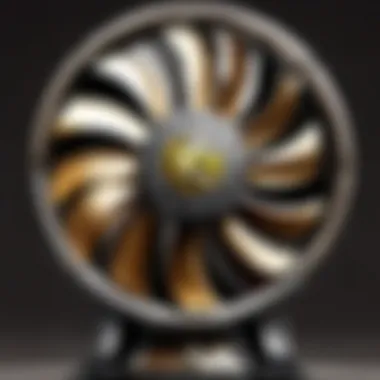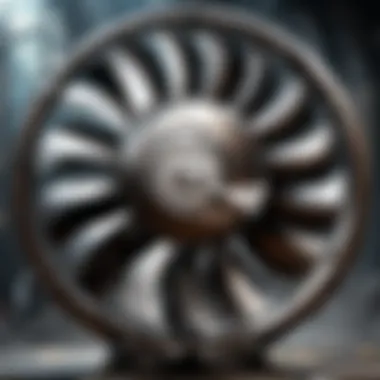Unveiling the Cooling Efficacy of Metal Bladed Fans: A Comprehensive Analysis


Cooling Efficiency Enhancement with Metal Bladed Fans
Throughout many industries and applications, the influence of metal bladed fans on cooling efficiency is profound and intricate. The design and composition of these fans play a pivotal role in optimizing performance, making them a crucial component in achieving superior cooling capabilities. By delving into the operational advantages of metal bladed fans, a deeper understanding of their impact on cooling systems emerges.
Metal bladed fans excel in dissipating heat effectively due to their robust construction and precise engineering. As opposed to traditional fans with plastic blades, metal blades offer enhanced durability and air circulation efficiency, resulting in better heat dissipation. The material composition ensures a longer lifespan and consistent cooling performance, making them a preferred choice in various cooling applications.
Moreover, the structural design of metal bladed fans contributes significantly to their cooling efficiency. With optimized blade configurations and material properties, these fans can generate higher airflow levels while maintaining low noise levels. This optimized design not only enhances cooling performance but also reduces energy consumption, making them an eco-friendly and cost-effective cooling solution.
Introduction
In the realm of cooling systems, metal bladed fans stand out as pivotal components that significantly enhance cooling efficiency across multiple applications. These robust fans, with their intricate design and material composition, play a crucial role in maintaining optimal operating temperatures in various settings. Understanding the nuances of metal bladed fans is imperative for anyone seeking to optimize cooling performance.
Overview of Metal Bladed Fans
Metal bladed fans, characterized by their use of materials such as aluminum, steel, and titanium, offer superior durability and airflow management compared to traditional plastic fans. The design of these fans, coupled with their material composition, allows for efficient heat dissipation and enhanced cooling capabilities in diverse environments.
Importance of Cooling Systems
Cooling systems are essential in preventing overheating and ensuring the longevity of machinery and electronic components. Metal bladed fans contribute significantly to the effectiveness of cooling systems by providing enhanced airflow performance, reduced noise levels, and increased durability and reliability. Understanding the critical role of cooling systems in maintaining thermal equilibrium is paramount for optimizing operational efficiency and preventing heat-related damage.
Design and Construction


In the realm of cooling systems, the aspect of Design and Construction plays a pivotal role in determining the overall efficiency and performance. The intricate design, coupled with the quality of construction materials, directly impacts the airflow, cooling capacity, and durability of the fan. When focusing on metal bladed fans, the design becomes even more crucial due to the specific requirements of metal blades to ensure optimal cooling efficiency. Factors such as blade shape, structure, and the orientation of blades influence how effectively air is circulated and heat is dissipated. Additionally, the construction quality determines the fan's longevity and reliability in continuous operation.
Material Composition
Aluminum Blades
Aluminum blades are renowned for their lightweight yet durable nature, making them a popular choice for metal bladed fans. The key characteristic of aluminum blades lies in their ability to efficiently dissipate heat while reducing the overall weight of the fan assembly. This lightweight property contributes to lower energy consumption and quieter operation, making aluminum blades a preferred option for applications demanding high cooling efficiency. Despite being prone to corrosion in certain environments, the heat conductivity and cost-effectiveness of aluminum blades make them a viable choice for various cooling setups.
Steel Blades
Steel blades offer exceptional strength and durability, ideal for demanding cooling applications where reliability is paramount. The key characteristic of steel blades lies in their robustness and resistance to mechanical stress, ensuring prolonged usage without compromising performance. However, the heavier weight of steel blades compared to aluminum counterparts can lead to increased power consumption and noise levels. The durability and resilience of steel blades make them a suitable option for industrial cooling systems and environments requiring consistent performance under challenging conditions.
Titanium Blades
Titanium blades represent the pinnacle of material composition for metal bladed fans, combining strength, corrosion resistance, and lightweight properties. The key characteristic of titanium blades is their unparalleled durability and resistance to corrosion, making them ideal for applications where hygiene and longevity are essential. Despite being a premium choice, titanium blades offer superior performance and efficiency, especially in environments prone to humidity or aggressive chemicals. The unique feature of titanium blades lies in their ability to withstand extreme conditions while maintaining optimal cooling efficiency, making them a preferred option for specialized cooling solutions.
Blade Geometry
The blade geometry of a fan significantly influences its airflow performance and noise levels, directly impacting its cooling efficiency. Factors such as blade angle, shape, and curvature determine how effectively air is circulated within a system, affecting the overall cooling capacity. Optimizing blade geometry involves intricate design considerations to minimize turbulence, maximize airflow, and reduce noise output. By fine-tuning the blade geometry, manufacturers can enhance the fan's operational efficiency and reduce energy consumption, making it an essential aspect of metal bladed fan design.
Operational Efficiency


Operational efficiency plays a pivotal role in determining the overall performance of metal bladed fans in cooling applications. By focusing on this aspect, we can delve into the specific elements that drive the efficiency of these fans. The materials used in the construction of the blades, such as aluminum, steel, or titanium, significantly impact the operational efficiency of the fan. For instance, aluminum blades are lightweight and offer good conductivity, promoting efficient heat dissipation. On the other hand, steel blades provide robust durability but may add weight to the fan assembly, affecting its efficiency. Titanium blades strike a balance between strength and lightweight design, making them ideal for high-performance cooling systems. Understanding these material compositions is vital for engineers and enthusiasts looking to maximize the cooling efficiency of their systems.
Airflow Performance
Noise Levels
In the realm of cooling systems, noise levels represent a significant factor that influences user experience and operational comfort. Metal bladed fans, known for their sturdy construction, tend to operate with lower noise emissions compared to other fan types. The materials used in metal blades contribute to vibration dampening and noise reduction, promoting quieter operation in various applications. Furthermore, the balanced design of metal blades minimizes turbulence and friction-induced noise, enhancing the overall acoustic performance of the fan. Maintaining low noise levels is essential, especially in environments where quiet operation is paramount, such as offices, homes, and recording studios. By prioritizing noise reduction strategies, manufacturers can offer cooling solutions that are not only efficient but also acoustically pleasant.
Durability and Reliability
Durability and reliability are core aspects of metal bladed fans that significantly impact their effectiveness in cooling applications. Metal blades, crafted from robust materials like aluminum, steel, or titanium, exhibit excellent resistance to wear and tear, ensuring prolonged operational lifespan. The structural integrity of these blades imparts resilience against deformations and fractures, even under high-stress conditions, contributing to the fan's long-term reliability. Additionally, the corrosion-resistant properties of metal blades enhance their durability, making them suitable for a wide range of environments. Ensuring the longevity and reliability of cooling systems is essential to prevent downtime and maintenance issues, making metal bladed fans a dependable choice for critical cooling requirements.
Applications
When exploring the realm of metal bladed fans' impact on cooling efficiency, understanding their applications is paramount. Application areas range from industrial cooling systems, PC cooling fans, to automotive cooling solutions. Each sector offers unique challenges and requirements that metal bladed fans are adept at addressing. The adaptability and versatility of metal bladed fans make them indispensable in various cooling applications. Industries rely on these fans for efficient heat dissipation, ensuring operations run smoothly with optimal temperature regulation.
Industrial Cooling Systems (250- words)
Industrial cooling systems encompass a wide array of machinery and equipment that require effective thermal management. Metal bladed fans play a crucial role in these systems by providing enhanced airflow performance and superior cooling capabilities. The robust construction of these fans ensures durability and reliability in demanding industrial environments. From large-scale manufacturing plants to data centers, metal bladed fans are integral components that contribute to maintaining optimal operating temperatures and preventing overheating issues. The design and material composition of these fans are carefully engineered to withstand rigorous industrial conditions, making them a favored choice for cooling solutions in the industrial sector.
PC Cooling Fans (250- words)


PC cooling fans are essential for maintaining the performance and longevity of computer hardware components. Metal bladed fans offer efficient heat dissipation, keeping critical components such as the CPU and GPU within safe operating temperatures. These fans come in various sizes and designs to cater to different PC builds, providing customizable cooling solutions for enthusiasts and gamers. The airflow performance of metal bladed fans is crucial in reducing heat buildup and optimizing the overall thermal efficiency of gaming rigs and workstations. With minimal noise levels and high durability, metal bladed fans are a popular choice among PC users seeking reliable and effective cooling solutions.
Automotive Cooling Solutions (250- words)
Automotive cooling solutions rely on metal bladed fans to regulate engine temperatures and prevent overheating. In vehicles, these fans are instrumental in dissipating heat generated by the engine during operation. The design and construction of metal bladed fans for automotive use prioritize efficiency and compactness to fit within limited engine compartment spaces. By enhancing airflow and cooling performance, these fans contribute to the overall reliability and performance of vehicles. Whether in passenger cars or heavy-duty trucks, metal bladed fans play a vital role in ensuring engine longevity and optimal operating conditions on the road.
Maintenance and Care
In the realm of enhancing cooling efficiency with metal bladed fans, the aspect of Maintenance and Care emerges as a critical juncture. The longevity and optimal performance of these fans heavily rely on proper maintenance practices. Neglect in this area can lead to a decrease in efficiency and potentially increase the risk of malfunctions or breakdowns. By shedding light on Maintenance and Care, this article aims to underscore the pivotal role it plays in the overall functionality of metal bladed fans.
Cleaning and Lubrication
Within the domain of maintenance for metal bladed fans, the procedures of Cleaning and Lubrication stand out as fundamental practices. Cleaning the blades and ensuring they are free from dust, dirt, or any other debris is essential for maintaining optimal airflow performance. Lubricating the moving parts of the fan mechanism also aids in reducing friction and ensuring smooth operation. Regular Cleaning and Lubrication not only preserve the efficiency of the fan but also extend its lifespan, making it a cost-effective approach in the long run as well.
Troubleshooting Common Issues
As with any mechanical system, metal bladed fans are susceptible to various common issues that may impede their performance. From problems with motor functionality to issues with blade alignment or balance, troubleshooting these common issues is paramount in ensuring uninterrupted cooling operations. By addressing these issues proactively, users can prevent potential damages to the fan and maintain a consistent level of cooling efficiency. This section will delve into some prevalent issues that users may encounter with metal bladed fans, offering insightful solutions to overcome these challenges effectively.
Future Trends
In the realm of metal bladed fans and their impact on cooling efficiency, exploring future trends becomes paramount. The rapid evolution of fan technology necessitates an understanding of the upcoming advancements that will shape the cooling landscape. Predicting future trends in this domain requires a keen eye on innovation, efficiency, and sustainability. As technologies progress, the focus shifts towards enhancing airflow, reducing noise levels, and improving fan durability. Integrating smart systems into fan operations emerges as a pivotal trend, revolutionizing how cooling systems function in various applications. By embracing these future trends, users can expect enhanced performance, increased energy efficiency, and seamless integration with evolving technological ecosystems.
Advancements in Fan Technology
The continuous advancements in fan technology play a crucial role in optimizing cooling efficiency. Innovations in fan blade design, materials, and motor technology contribute to higher airflow performance and lower power consumption. The integration of aerodynamic principles into fan design enhances airflow direction and efficiency, leading to improved cooling capabilities. Advanced fan materials such as composite alloys and carbon fiber offer increased durability and lighter weight, further boosting operational efficiency. Fan motors incorporating intelligent control systems enable dynamic speed adjustments, allowing for precise temperature regulation and energy savings. These advancements collectively result in superior cooling performance, making metal bladed fans a reliable choice for various cooling applications.
Integration with Smart Systems
The integration of metal bladed fans with smart systems marks a significant leap forward in cooling technology. Smart systems equipped with sensors, microcontrollers, and connectivity features enable real-time monitoring and control of fan operations. By utilizing data analytics and machine learning algorithms, smart fans can autonomously adjust settings to optimize cooling efficiency based on environmental conditions and user preferences. Integration with smart home platforms allows for seamless integration into IoT ecosystems, enabling remote access and automated scheduling. The adoption of smart systems enhances user experience, improves energy efficiency, and contributes to overall system reliability, making metal bladed fans an intelligent choice for modern cooling solutions.





